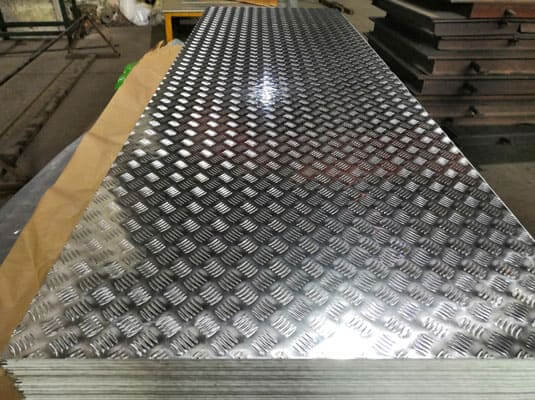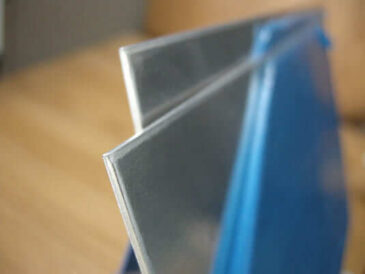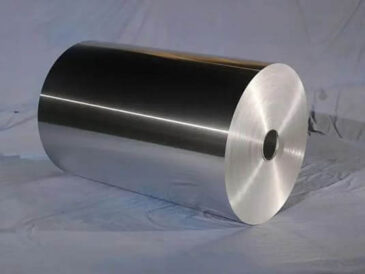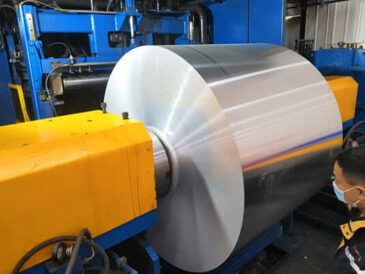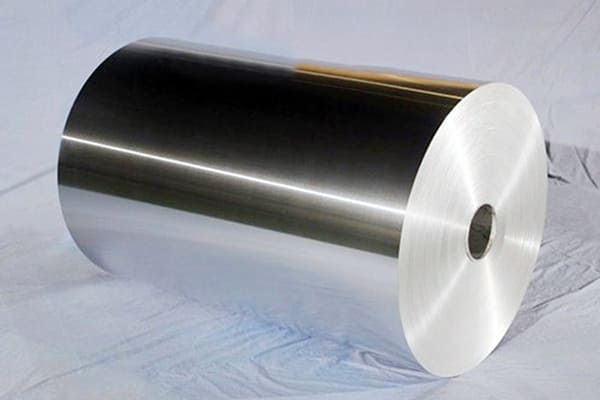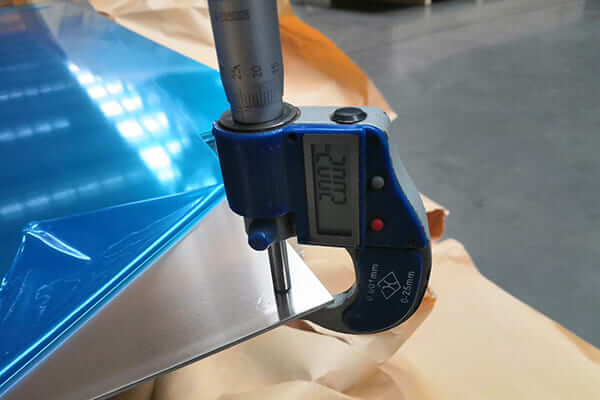What is 6000 series aluminum alloy
6000 series aluminum alloy is a high-strength aluminum alloy that can be strengthened by heat treatment. Its main components are aluminum, magnesium, silicon, etc. It has high strength and good corrosion resistance.
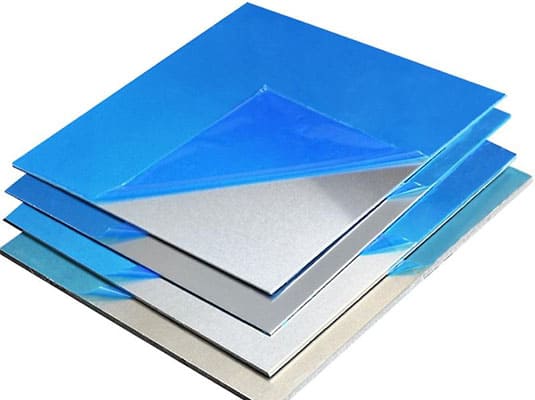
6000 series aluminum alloy
6000 series aluminum alloys are mainly divided into several alloys such as 6005, 6060, 6061, 6063, and 6082. Among them, 6061 aluminum alloy has high strength and good welding performance, and is widely used in transportation, building decoration, mechanical equipment and other fields.
Introduction to 6000 series aluminum alloys of different alloys
6061 aluminum alloy
6061 is very popular in medium to high strength applications due to its characteristic toughness. It is the most versatile and widely used of all other 6000 series alloys due to its heat treatability and relative ease of processing and welding. 6061 aluminum contain magnesium and silicon, which makes them more corrosion-resistant even on wearing surfaces.
Uses for this form of 6000 series alloys range from transportation and infrastructure to more everyday uses such as fly fishing reels, gun suppressors, non-flight critical aircraft components and automotive components. 6061 is available in many forms, including extruded sheet and forgings.
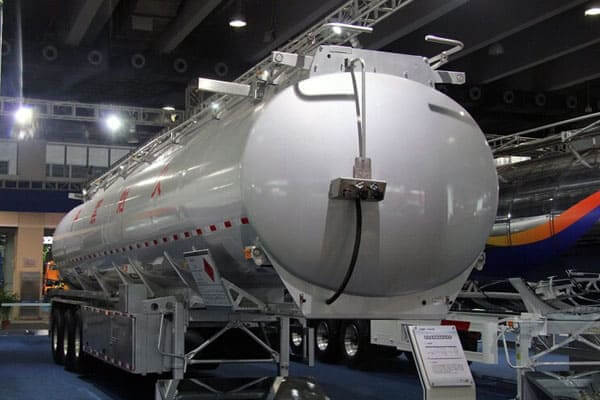
6061 aluminum sheet application
6063 aluminum alloy
6063 is also an aluminum alloy containing magnesium and silicon. First, it has lower magnesium and silicon content and is only half as strong as 6061, making it suitable for applications where strength is not a fundamental consideration. Secondly, the lower alloy content can also achieve higher surface finish standards.
Common uses of 6063 aluminum alloy sheet include door and window frames, non-load-bearing columns, roofs, decorative structures, railings, furniture, marine and motor vehicle parts, and electrical components such as conduits and irrigation system pipes. 6063 aluminum alloy is highly corrosion-resistant and protects against environmental degradation.
6082 aluminum alloy
Often referred to as a “structural alloy,” 6082 alloy is one of the strongest of all 6000 series aluminum alloys. This is a great option for engineers who don’t want to invest in the stronger 2xxx/7xxx series, and is also capable of extruding more complex shapes not possible in 2xxx/7xxx aluminum alloys.
6082 is an aluminum alloy of silicon and manganese. Known for its machinability, it also has excellent weldability, cold formability and corrosion resistance. Its high manganese content allows it to control its grain structure, resulting in a stronger alloy ideal for general-purpose applications requiring extra strength and toughness. One drawback is that it is more difficult to form thin-walled, complex extruded shapes with 6082 alloy than with other alloys in the 6000 series.
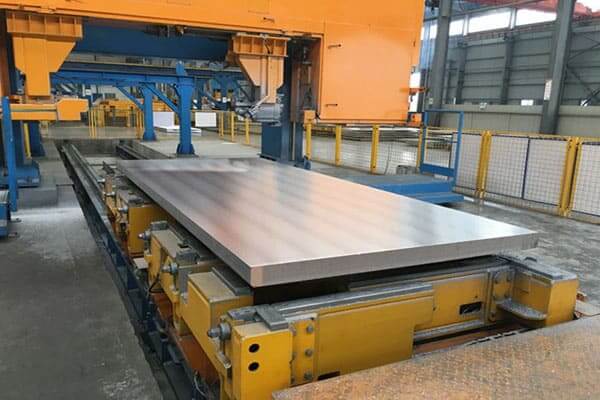
6000 series aluminum alloy producting
6082 aluminum alloy is a relatively new alloy in North America that is gaining wider acceptance, and in some applications it can replace 6061 due to its higher strength capabilities. It is commonly used in high stress applications such as bridges, towers, trusses, automotive structures and marine structural applications.
6005 and 6005A aluminum alloy
6005 aluminum alloy contains large amounts of silicon, which lowers its melting point and enhances its extrudability. 6005A, on the other hand, contains higher levels of chromium, which reduces its susceptibility to stress corrosion and increases its toughness. 6005A also contains additional manganese, which increases its strength and extrudability. It can be difficult to produce thin-walled and complex extrusions using 6005, but it still has better extrusion properties than 6082.
Both 6005 and 6005A have excellent bending capabilities and a better milling surface finish than 6061. Both alloys can be easily welded or brazed using commercial methods, but the heat generated by welding will reduce the strength of the alloy. Both 6005 and 6005A have excellent corrosion resistance and surface treatment properties and respond well to standard anodizing methods, producing clear, transparent and colored dyes as well as hardcoat finishes.

2mm aluminum sheet of 6000 series
6005 and 6005A are commonly used in applications requiring complex extrusion such as furniture tubing, rail and bus components, pipes, portable ladders and applications requiring the greater strength of 6063, as well as some marine applications.
6005, 6005A, 6061 and 6082 are quite similar and in some cases interchangeable, but the extrusion quality and milled surface finish of 6005 and 6005A are much better than 6061 and 6082.
Features of 6000 series aluminum alloy
- 1. Lightweight: 6000 series aluminum alloy has a lower density and is about one-third lighter than steel, so it is widely used in aerospace, automotive and other fields.
- 2. High strength: Through alloying and heat treatment, 6000 series aluminum alloy can obtain higher strength and meet various engineering needs.
- 3. Good corrosion resistance: The magnesium element in the alloy can improve the corrosion resistance of the alloy, making it have better corrosion resistance in harsh environments.
- 4. Easy to process: 6000 series aluminum alloy has good processability and can be processed by various processing techniques such as forging, extrusion, and casting, and can be made into parts with complex shapes.
- 5. Good weldability: The magnesium element in the alloy can increase the welding performance of the alloy, making it suitable for various welding methods.
Comparison of chemical composition of 6000 series aluminum alloys
| Alloy | Mn | Fe | Cu | Mg | Si | Zn | Ti | Cr | Residuals : | Al |
| 6060 | 0.0–0.1% | 0.1–0.3% | 0.0–0.1% | 0.35–0.6% | 0.3–0.6% | 0.0–0.15% | 0.0–0.1% | 0.050–0.25% | 0.0–0.15% | 97.5–99.3% |
| 6061 | 0.0–0.15% | 0.0–0.7% | 0.15–0.4% | 0.8–1.2% | 0.4–0.8% | 0.0–0.25% | 0.0–0.15% | 0.040–0.35% | 0.0–0.15% | 95.9–98.6% |
| 6063 | 0.0–0.1% | 0.0–0.35% | 0.0–0.1% | 0.45–0.9% | 0.2–0.6% | 0.0–0.1% | 0.0–0.1% | 0.0–0.1% | 0.0–0.15% | 97.5–99.4% |
| 6082 | 0.6–1.2% | 0.0–0.5% | 0.0–0.1% | 0.6–1.2% | 0.7–1.3% | 0.0–0.2% | 0.0–0.1% | 0.0–0.25% | 0.0–0.15% | 95.2–98.3% |
Analysis of chemical composition of 6000 series aluminum alloy
6000 series aluminum alloy is a common aluminum alloy material with good strength and corrosion resistance. It is composed of elements such as aluminum, magnesium and silicon, and has excellent mechanical properties and heat treatment plasticity.
6000 series aluminum alloy is mainly composed of aluminum, magnesium and silicon. Among them, aluminum is the main component of the alloy, accounting for most of the total mass. Aluminum is lightweight, corrosion-resistant and has good thermal conductivity, which makes 6000 series aluminum alloys have a wide range of applications.
Magnesium is one of the important alloying elements of 6000 series aluminum alloys, usually accounting for 1-2% of the total mass of the alloy. The addition of magnesium can significantly improve the strength and hardness of the alloy, while increasing the alloy’s heat resistance and corrosion resistance. In addition, magnesium can also improve the processing properties of the alloy and improve its plasticity and weldability.
Silicon is another important alloying element, and its content in 6000 series aluminum alloys is usually 0.4-0.8%. The addition of silicon can increase the strength and hardness of the alloy while improving its heat resistance and corrosion resistance. In addition, silicon can improve the fluidity of the alloy and facilitate formation during casting and heat treatment.
In addition to aluminum, magnesium and silicon, 6000 series aluminum alloys may also contain other trace elements, such as copper, manganese, chromium and zinc. The addition of these elements can further improve the properties of the alloy, such as increasing its strength, hardness and corrosion resistance.
6000 series aluminum alloy has good mechanical properties and heat treatment plasticity. Through heat treatment, the structure and properties of the alloy can be further adjusted to meet different engineering requirements. Common heat treatment methods include solution treatment and aging treatment. Solid solution treatment can dissolve the solute atoms in the alloy into the matrix and improve the strength and hardness of the alloy. Aging treatment further improves the strength and hardness of the alloy by storing it at an appropriate temperature for a period of time to further precipitate the solute atoms in the alloy and form a dispersed strengthening phase.
6000 series aluminum alloy applications
6000 series aluminum alloy has a wide range of applications. Due to its good strength and corrosion resistance, it is often used to manufacture various structural parts and components, such as aerospace, automotive, construction and electronics. In addition, 6000 series aluminum alloy also has good processability and weldability, making it more convenient and economical during the manufacturing process.

6000 series aluminum alloy for shipbuilding
- 1. Automobile industry: 6000 series aluminum alloy is widely used in automobile bodies, frames, engine parts, etc., which can reduce the weight of the vehicle and improve fuel economy and driving stability.
- 2. Aerospace industry: Due to the light weight and high strength of 6000 series aluminum alloy, it is widely used in important components such as aircraft structural parts and fuel tanks.
- 3. Construction industry: 6000 series aluminum alloy is often used in the construction field to manufacture doors, windows, curtain walls, aluminum alloy profiles, etc. It has good corrosion resistance and decorative properties.
- 4. Electronic and electrical appliances: 6000 series aluminum alloy is often used in the field of electronic and electrical appliances to manufacture radiators, electronic housings, etc., and has good thermal and electrical conductivity.
- 5. Sports equipment: 6000 series aluminum alloy is widely used in the field of sports equipment such as bicycles, golf clubs, skateboards, etc. It has the characteristics of light weight and high strength.
Casting production process and its introduction
The purpose of melting and casting is to produce alloys with satisfactory composition and high purity of melt, so as to create favorable conditions for casting alloys of various shapes.
Melting and casting process steps: batching --- feeding --- melting --- stirring after melting, slag removal --- pre-analysis sampling --- adding alloy to adjust the composition, stirring --- refining --- static Setting——Guide furnace casting.
Hot rolling production process and its introduction
- 1. Hot rolling generally refers to rolling above the metal recrystallization temperature;
- 2. During the hot rolling process, the metal has both hardening and softening processes. Due to the influence of deformation speed, as long as the recovery and recrystallization process is too late, there will be a certain work hardening;
- 3. The recrystallization of the metal after hot rolling is incomplete, that is, the coexistence of recrystallized structure and deformed structure;
- 4. Hot rolling can improve the processing performance of metals and alloys, reduce or eliminate casting defects.
- 1. The casting and rolling temperature is generally between 680°C and 700°C. The lower the better, the stable casting and rolling line usually stops once a month or more to re-stand. During the production process, it is necessary to strictly control the liquid level of the front tank to prevent low liquid level;
- 2. Lubrication uses C powder with incomplete combustion of gas for lubrication, which is also one of the reasons for the dirty surface of casting and rolling materials;
- 3. The production speed is generally between 1.5m/min-2.5m/min;
- 4. The surface quality of products produced by casting and rolling is generally relatively low, and generally cannot meet products with special physical and chemical performance requirements.
- 1. Cold rolling refers to the rolling production method below the recrystallization temperature;
- 2. There will be no dynamic recrystallization during the rolling process, and the temperature will rise to the recovery temperature at most, and the cold rolling will appear in a work hardening state, and the work hardening rate will be large;
- 3. The cold-rolled sheet and strip have high dimensional accuracy, good surface quality, uniform structure and performance, and products in various states can be obtained with heat treatment;
- 4. Cold rolling can roll out thin strips, but at the same time, it has the disadvantages of high energy consumption for deformation and many processing passes.
- 1. Finishing is a processing method to make the cold-rolled sheet meet the customer's requirements, or to facilitate the subsequent processing of the product;
- 2. The finishing equipment can correct the defects produced in the hot rolling and cold rolling production process, such as cracked edge, oily, poor plate shape, residual stress, etc. It needs to ensure that no other defects are brought into the production process;
- 3. There are various finishing equipments, mainly including cross-cutting, slitting, stretching and straightening, annealing furnace, slitter, etc.
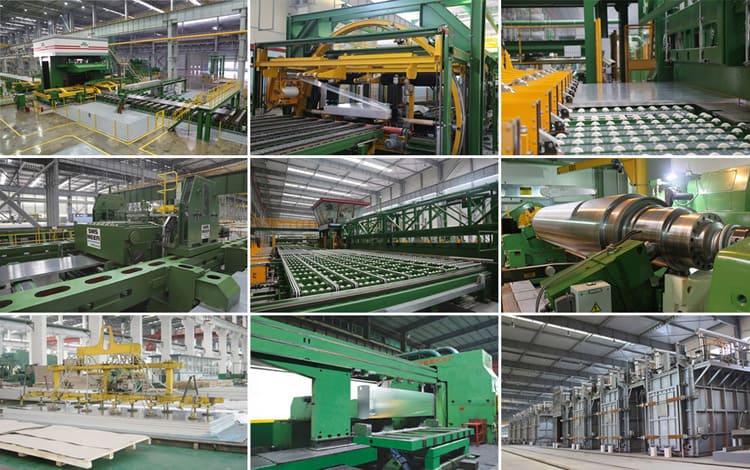
Casting and rolling process
Casting and rolling process: liquid metal, front box (liquid level control), casting and rolling machine (lubrication system, cooling water), shearing machine, coiling machine.
Cold rolling production process

Introduction to finishing production process
Aluminum alloy has the characteristics of low density, good mechanical properties, good processing performance, non-toxic, easy to recycle, excellent electrical conductivity, heat transfer and corrosion resistance, so it has a wide range of applications.
Aerospace: used to make aircraft skins, fuselage frames, girders, rotors, propellers, fuel tanks, wall panels and landing gear struts, as well as rocket forging rings, spacecraft wall panels, etc.
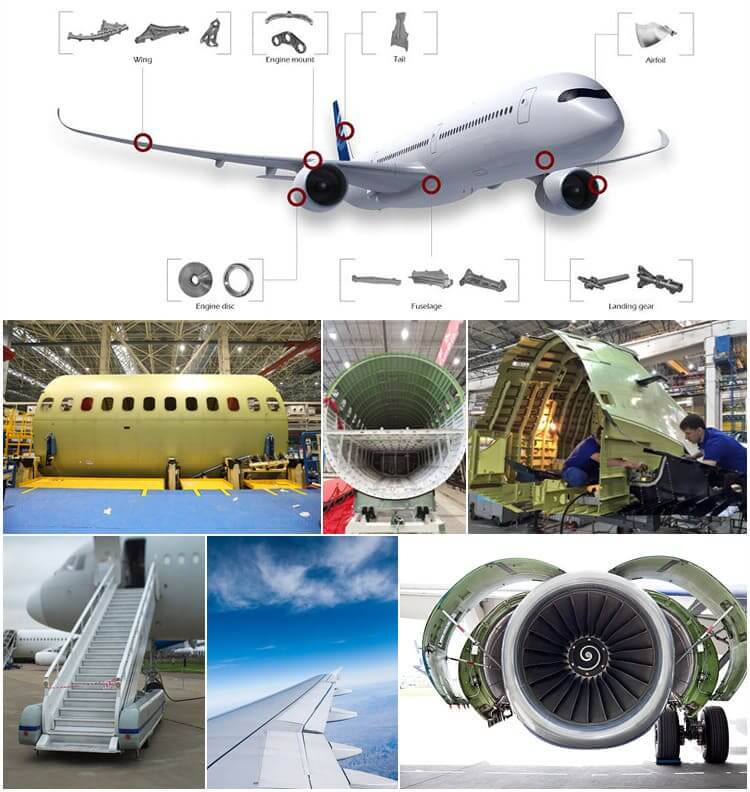
Aluminum alloy used for aerospace
Transportation: used for car body structure materials of automobiles, subway vehicles, railway passenger cars, high-speed passenger cars, doors and windows, shelves, automotive engine parts, air conditioners, radiators, body panels, wheels and ship materials.
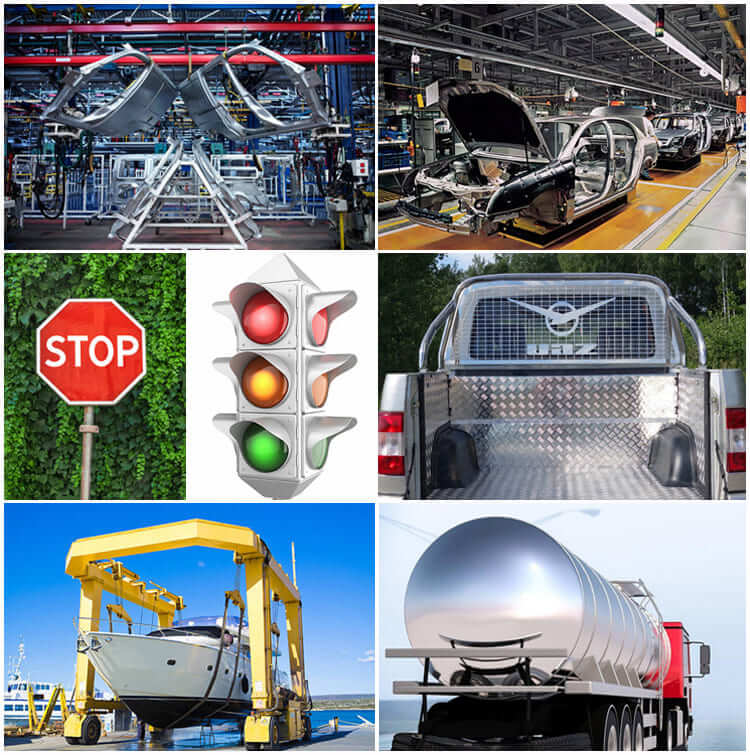
Traffic application
Packaging: All-aluminum pop cans are mainly used as metal packaging materials in the form of thin plates and foils, and are made into cans, lids, bottles, barrels, and packaging foils. Widely used in the packaging of beverages, food, cosmetics, medicines, cigarettes, industrial products, medicines, etc.
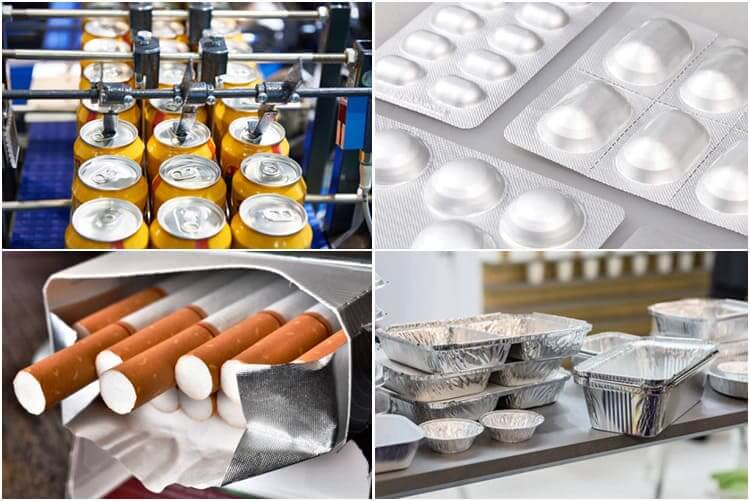
Packaging application
Printing: Mainly used to make PS plates, aluminum-based PS plates are a new type of material in the printing industry, used for automatic plate making and printing.

PS printing
Architectural decoration: aluminum alloy is widely used in building structures, doors and windows, suspended ceilings, decorative surfaces, etc. due to its good corrosion resistance, sufficient strength, excellent process performance and welding performance.
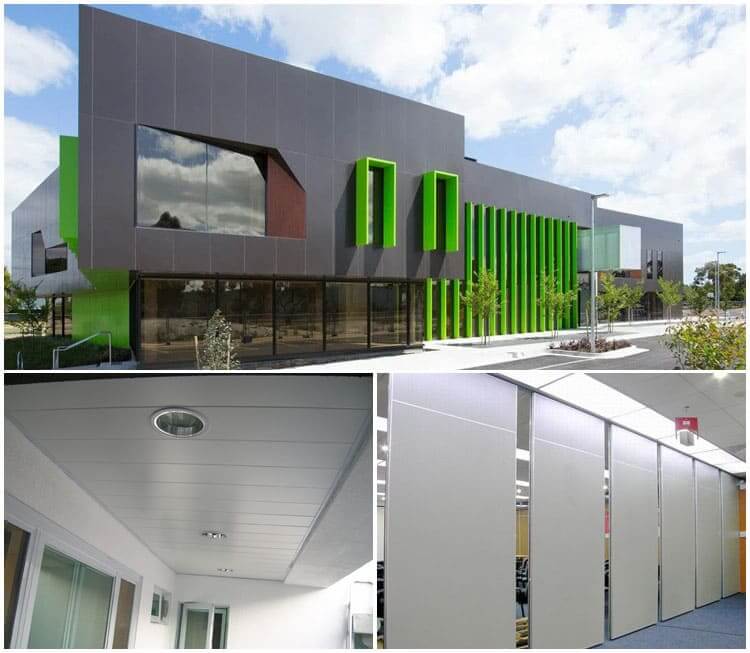
Aluminum alloy construction application
Electronic products: computers, mobile phones, refrigerator shells, radiators, etc.

Electronic product application
Kitchen supplies: aluminum pots, aluminum basins, rice cooker liners, household aluminum foil, etc.

Kitchen application
Packaging Of Aluminum Sheet/Coil
Every detail of packaging is where we pursue perfect service. Our packaging process as a whole is as follows:
Lamination: clear film, blue film, micro-mucosal, high-mucosal, laser cutting film (2 brands, Novacell and Polyphem);
Protection: paper corner protectors, anti-pressure pads;
drying: desiccant;
Tray: fumigated harmless wooden tray, reusable iron tray;
Packing: Tic-tac-toe steel belt, or PVC packing belt;
Material Quality: Completely free from defects such as white rust, oil spots, rolling marks, edge damage, bends, dents, holes, break lines, scratches, etc., no coil set.
Port: Qingdao or other ports in China.
Lead time: 15-45 days.

Aluminum sheet/plate packaging process
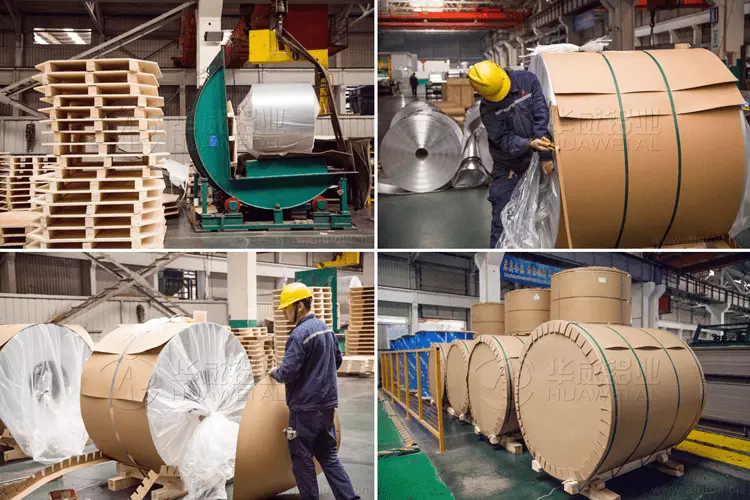
Aluminum coil packaging process
F: Are you a manufacturer or a trader?
Q: We are a manufacturer, our factory is at No.3 Weier Road, Industrial Zone, Gongyi, Henan, China.
F: What is the MOQ for ordering the product?
Q: Our MOQ is 5 tons, and some special products will have a minimum order quantity of 1 or 2 tons.
F: How long is your lead time?
Q: Generally our lead time is about 30 days.
F: Do your products have quality assurance?
Q: Yes, if there is a quality problem with our products, we will compensate the customer until they are satisfied.
Related Products
Latest Blogs
6061 vs 7075 aluminum
"6061" and "7075" are two common aluminum alloy grades, which are widely used in many industrial fields, especially in aviation, aerospace, transportation and structural manufacturing.
Aluminum Foil Used in Air Fryers
Aluminum foil is widely used in daily life, mainly due to its light weight, good ductility, moderate price, and excellent heat conduction and light-shielding properties.
Reasons why the surface of honeycomb aluminum foil cannot be bonded with the adhesive
Aluminum honeycomb panels have good performance in use. They have good strength and good impact resistance. They can be well designed in use. Therefore, they are widely used at present.
Introduction hardness of 1000-8000 series aluminum alloys
1000-8000 series basically covers all aluminum alloy series products. Different series of products have different performance and hardness.

